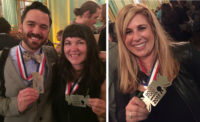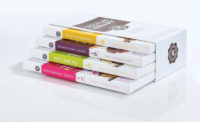The Fine Chocolate Industry Association held the ninth annual summer conference, “Elevating the art and flavor of fine chocolate,” June 30 in New York City.
The conference brought together a galaxy of highly regarded craft chocolate makers, chocolatiers, pastry chefs, suppliers and related industries from around the world.
According to Executive Director Bill Guyton, the theme was selected “since it demonstrates the growth and maturity of the fine chocolate market over the past few years and the exciting new opportunities ahead for expansion.” The association defines fine chocolate as a segment that focuses on excellence in quality ingredients and tastes.
Hoping to glean knowledge from other successful categories of craft food, the keynote presentation was “Learning from other Industries.” Panelists included Ron Tanner, Specialty Food Association, Philanthropy, Government and Industry Relations; Rick Peyser, Sr., formerly with Keurig Green Mountain; and Jason Sahler, head brewer, Strong Rope Brewery.
Tanner noted that specialty food sales topped $140.3 billion in 2018, with 78 percent of these sales coming through retail and 22 percent through foodservice. Specialty food represents 15.8 percent of all food sales at retail. Between 2013 and 2017, sales of specialty food jumped by 12.9 percent, while sales of all food increased just 1.4 percent. Chocolate and other confectionery is the industry’s sixth largest category, at $2.37 billion. Thirty percent of specialty food consumers have purchased chocolate in the past six months, with 10 percent having done so online.
Peyser explained that when the Specialty Coffee Association was established in 1982, it created several special interest committees, and that objective might be beneficial to FCIA. The committees included a Standards Committee that developed sensory and physical standards and a Sustainability Committee that focuses on organic certification. Since then, the latter committee has become the hallmark of the association, having fostered a mechanism for developing a robust supply chain.
One audience member asked the panel, “In our association, we get caught up in terminology. Should we call ourselves ‘fine’, ‘craft’, or ‘specialty’ chocolate? And also, when does craft no longer become craft?”
Tanner noted there are a variety of terms used in the food industry and all have their own definitions, adding “Fancy Food Show” doesn’t adequately describe the show now.
“We would love to change the name of that show into something other than the Fancy Food Show,” he said,” but back in 1955, when our association was founded, that’s what those products were called. Nowadays, our products called specialty or craft or artisanal, but not really ‘fine foods.’ But now that McDonald’s offers an artisanal chicken sandwich, we kind of have to look to see what’s going on there.
“I think craft is a good word, as it connotes there is a person behind the product,” Tanner added. “So that’s why we use the word specialty, because it gives the idea that our members are producing something special, not something mass-produced. We think that works for us.”
Peyser noted the Specialty Coffee Association developed affinity groups or guilds, enabling people to come together and learn very specifically some of the skills. So, for example, there is a Roasters Guild, Baristas Guild and Technicians Guild for people who service coffee equipment. These initiatives helped the association move forward and strengthen the industry overall.
Sahler mentioned that the establishment of the Craft Brewers Association helped give the fledgling industry an identity in the market that consumers could quickly relate to, and with that branded identity, the industry was able to grow and expand.
What is the current state of the craft chocolate segment?
That’s what premium confectionery trend watcher Curtis Vreeland asked attendees at the Fine Chocolate Industry Association Summer 2018 conference. The interviewees ranged from equipment and cocoa bean suppliers, to bean-to-bar chocolate makers) and chocolatiers, to merchandisers. Each interviewee was given a placard and asked to point the arrow in the direction that signals his/her sentiment for the segment.
The consensus of these interviewees is this: Like a summer lobster anxious to molt its shell, the craft chocolate industry, now 20 years old, needs to expand beyond its limited foodie base. Some supporting elements for this expansion are already in place — improved access to supplies of fine flavor beans, availability of scalable equipment and culinary schools training eager novice chocolate makers.
But one challenge remains: how to attract more consumers or, to use our crustacean analogy, how to justify the investment in a larger shell?
As a possible solution, the industry is trying to channel other successful craft food industries. Such as the craft beer industry that converted legions of lite beer guzzlers into beer cognoscenti willing to pay three times the price for a pint of limited run, local brew.
First up, those seeing that the craft chocolate “glass” is half empty:
Clay Gordon
TheChocolateLife.com, Founder & moderator
The market is fragile. There is more supply (fine flavor cacao beans and craft chocolate bars) than demand (consumers). The challenge becomes: How do you double the number of consumers? We are not going to get the same consumer to buy three times more chocolate. The industry can’t grow organically with the same consumer base. How are you going to convert those folks who consider mass-market luxury chocolate available at $3/bar as the best chocolate in the world? How do you convince them to pay three times as much for the same amount of chocolate? The Fine Chocolate Industry Association is part of the solution; but on its own, it can’t do it. Adding more product variety might help, as too many craft chocolate makers are producing two-ingredient, single-origin bars with a mix of challenging flavors.
Jorge Redmond
Chocolates El Rey, President and CEO
I have mixed feelings. It’s a newfangled way of getting high-quality chocolate into the markets. There are serious impediments to market penetration. Costs are an issue. While we buy directly from the Venezuelan growers and have an advantage on that aspect, a lot of these craft chocolate makers are buying their cacao from intermediaries at two to three times what it’s worth at the source. So, from a philosophical point of view, craft chocolate makers are wonderful; but from an economic point of view, I wonder.
Adrienne Henson
2Beans NYC, Retail chocolate salesperson
I have mixed feelings. Here in New York City, the market has become very saturated. Retail stores seem to be dwindling, and there are more purchasing options through chocolate subscription buying clubs and online purchases. And shelf space is limited. At 2Beans, we can display only about 20 different bars. Right now, 100 percent bars are selling really well, being driven by health (no sugar) considerations. Also, people are annoyed that the wrappers are bigger than the bar, leaving a lot of packaging empty space. I have to do a lot of explaining as to why that craft chocolate bar is so expensive. If people like a bar they will pay $15 to $20; others only want to spend about $3 to $4, and they are satisfied with the purchasing mini-bars; little bites do well.
And those seeing that the craft chocolate “glass” is half full:
Dennis MacRay
Theo Chocolate, CEO
We’re really bullish on the craft chocolate industry; that’s how Theo Chocolate got started, and now we have grown to be a national brand. Using the specialty coffee industry, where I worked before Theo, as a guide, there’s still room for growth. On the one hand, the ability to aggregate cacao purchases, like what Uncommon Cacao is doing, brings down manufacturing cost and risk. I wish we had that option available to us 10 years ago at Theo because we had to take huge risks to get single origin, fine flavor cacao. On the other hand, it is a very competitive retail market, which might be a good sign, given that one craft chocolate maker doesn’t make a market. So, I don’t necessarily think there is a lack of consumer interest, the challenge is upscaling those consumers away from conventional chocolate.
Balu Bala
Cocoatown, Founder, Equipment manufacturer
It depends upon which market we are talking about: domestic or international. In the U.S., where the bean-to-bar market started about 20 years ago, the market generally has shifted away from hobbyists driven by their passion to how to make a financially viable business. They need an economic justification for entering and staying in the business. People will be hard-pressed to make money, so I anticipate growth slowing to 10 to 20 percent. Internationally, the market has been spreading to Asia, and in particular Japan, Taiwan, Korea, Philippines and Malaysia. Rising household incomes there are driving these sales, as is ready access to Asian-grown cacao beans.
Albert Chau
Fifth Dimension Chocolate, Founder
My chocolate company is based in London. In the UK, the bean-to-bar market started about 10 years ago with Duffey Chocolates. My company is about five years old and one of the first chocolatiers to make fine-flavored chocolate. I see the UK craft chocolate market expanding. Nowadays, there are more people understanding the craft or fine chocolate side and becoming more sophisticated in their choice of chocolate, rather than just looking at price and purchasing cheap chocolates. There’s more growth coming; our customers are being drawn from chocolate lovers upscaling there choices, as well as from new chocolate consumers.
Greg D’alesandre
Dandelion Chocolate, Chocolate Sourcer
I am very optimistic, both domestically and internationally. Over the last five years since we have been open, our retail shops have seen continuous double-digit growth. Overseas, we have two factories and four stores in Japan, and they have been growing like crazy. The biggest challenge we have is predicting that growth. We know things are going up, the question is by how much so that we can plan our production.
Emily Stone
Uncommon Cacao, Founder & CEO
I am optimistic. Over the past five years, we have seen a lot of new craft chocolate makers enter the market. Of those, about 15 percent seem successful and in the past two years are scaling up. I see the biggest constraint being access to working capital. There is such a time lag between buying the equipment and the beans, making the chocolate, distributing and selling it, and getting one’s money back. It would be good to see more innovative financial instruments available to this industry.
Sander Wolf
Dallas Chocolate Festival, Founder
I am definitely optimistic. All the pieces seem to be coming together. On the production side, more chocolate makers are entering the industry; the sourcing of beans is better and simpler; and the equipment is more turnkey. On the consumer side, there’s a better awareness of craft chocolate, driven by the growing popularity of craft food products in general. And there’s more product availability and variety. Our festival is in its ninth year. Last year, we had around 2,000 attendees and 60 exhibitors. We anticipate 25 to 30 percent growth this year.















